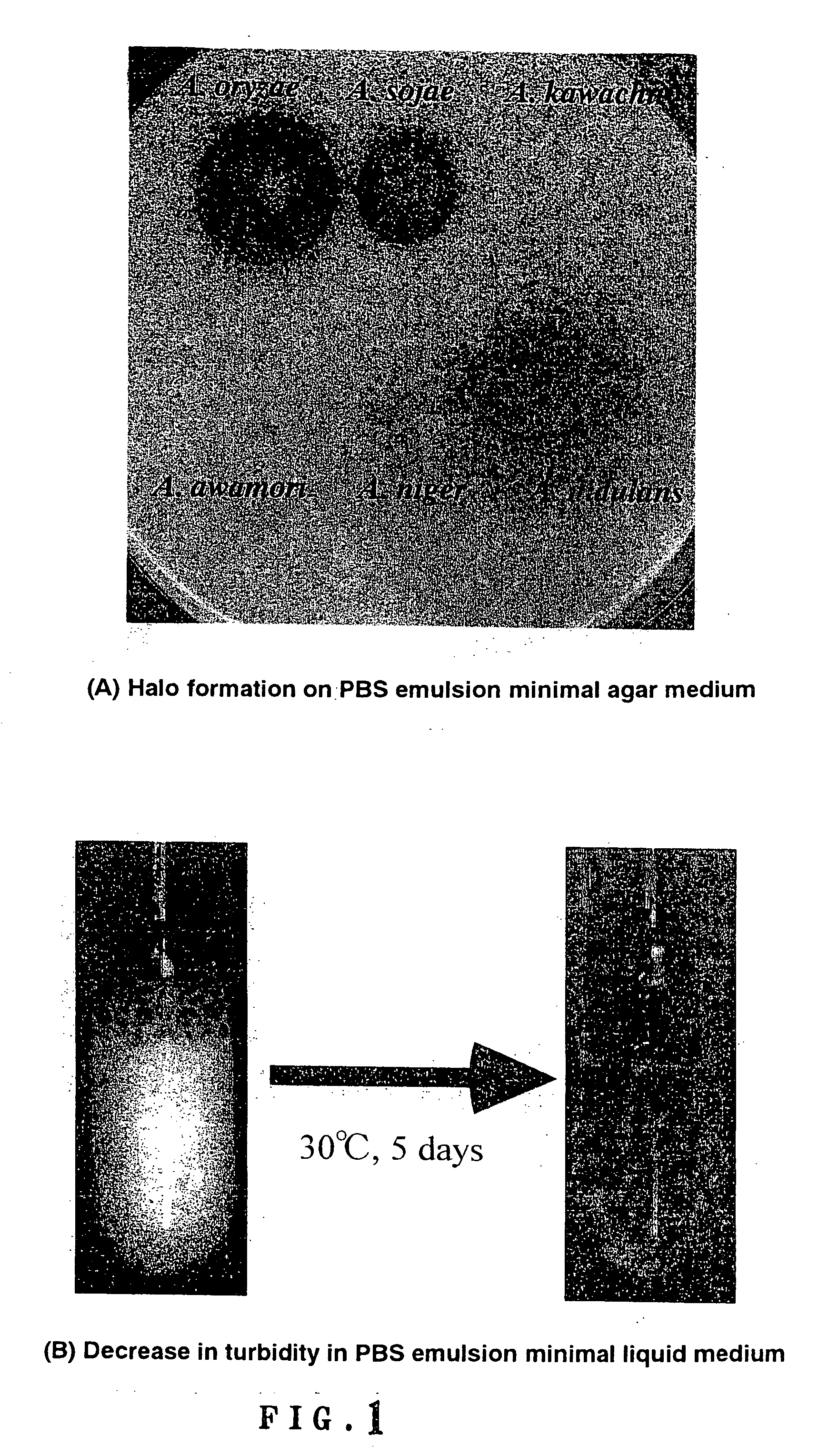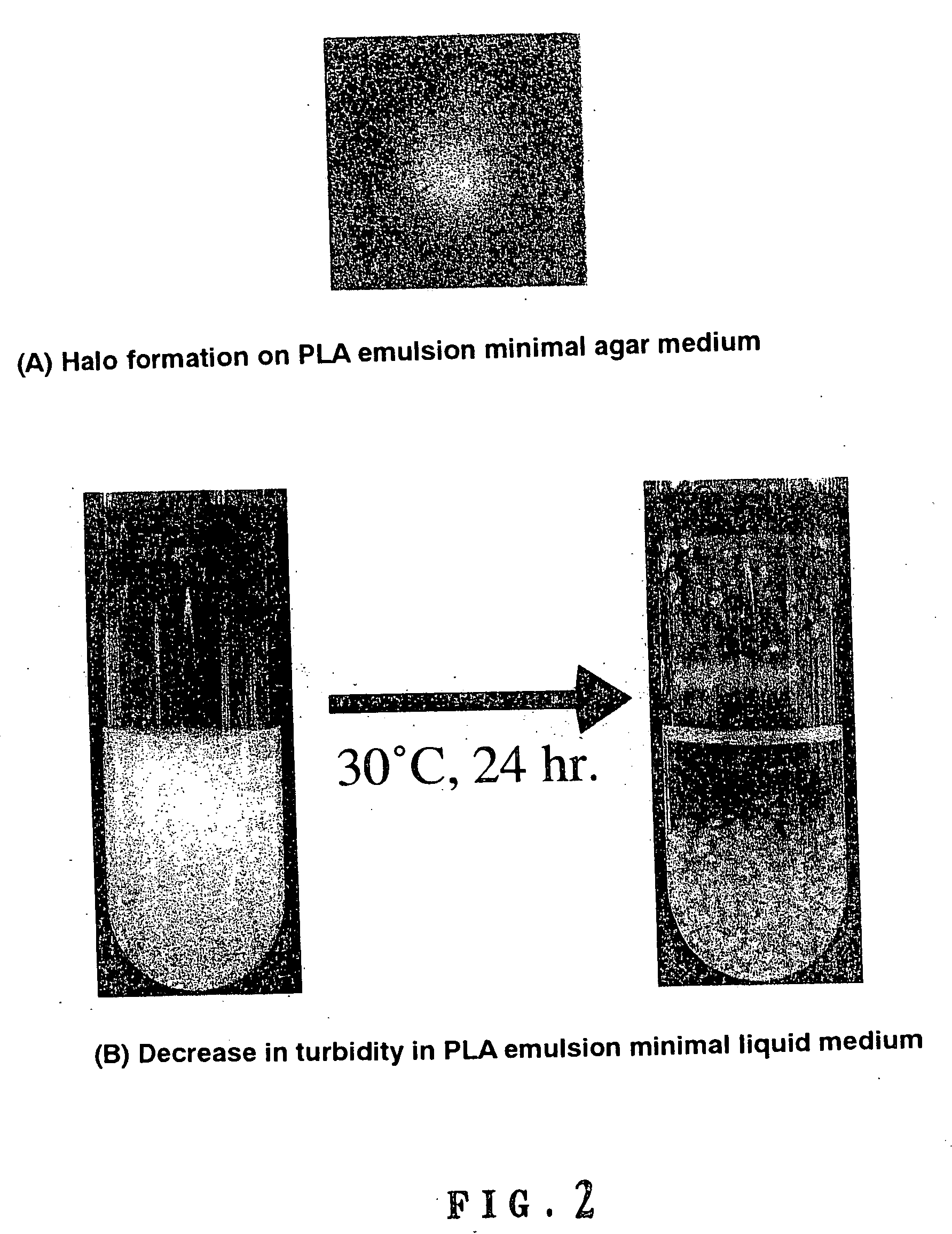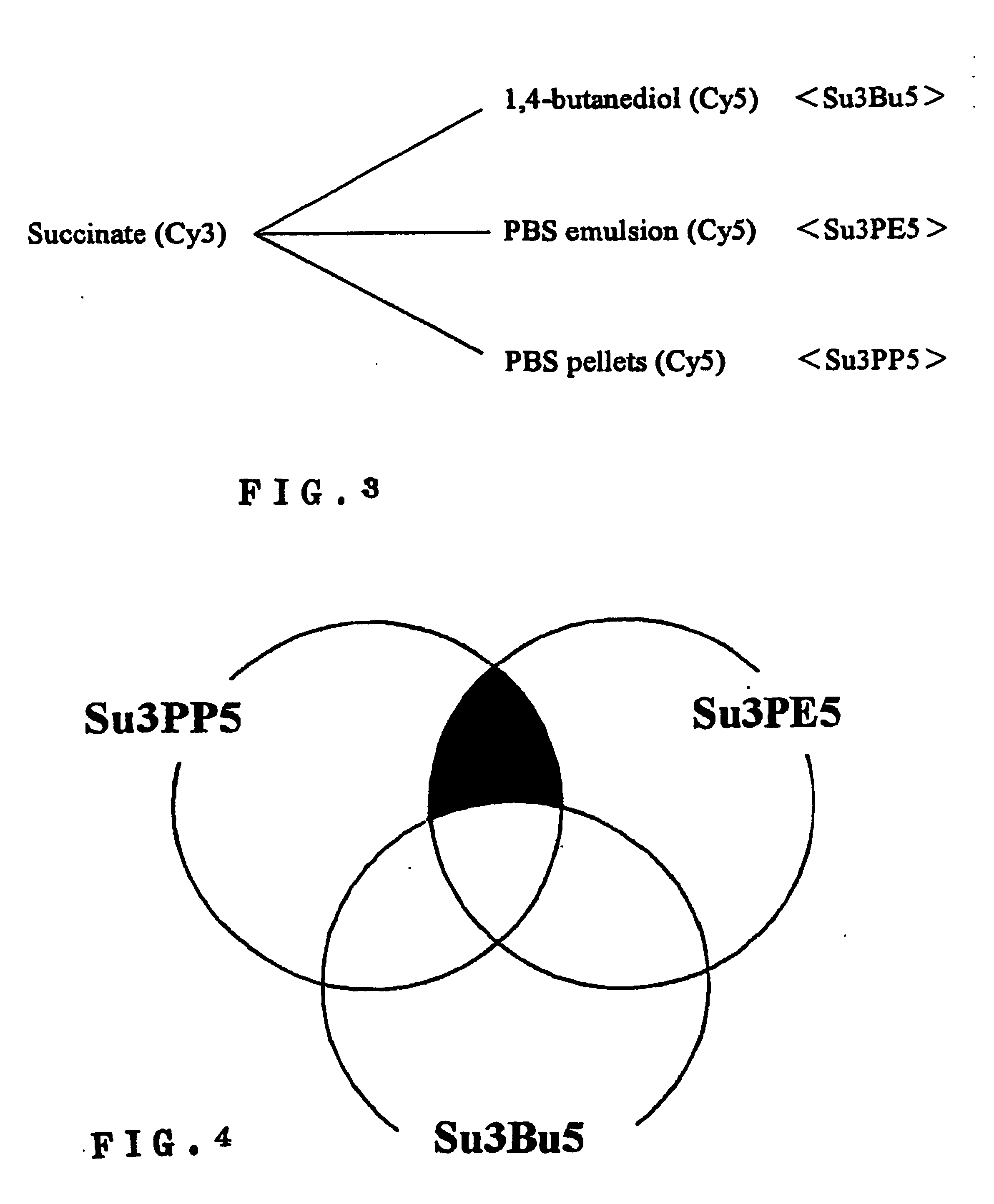Method of degrading plastic and process for producing useful substance using the same
a technology of plastic and degradable plastics, which is applied in the direction of biochemistry apparatus and processes, peptides, enzymology, etc., can solve the problems of low water activity, low cost of biodegradable plastics production, and inability to produce useful substances other than degraded plastic components, etc., to promote plastic degradation, low water activity, and increase water activity
- Summary
- Abstract
- Description
- Claims
- Application Information
AI Technical Summary
Benefits of technology
Problems solved by technology
Method used
Image
Examples
example 1
(1) Isolation of a Gene of Hydrophobin-Fungal Plastic-Attaching Factor
(1-1) Confirmation of the Conversion of Biodegradable Plastic With the Use of A. oryzae
[Materials]
1. Agent
[0130] Unless otherwise noted, a high quality agent of Nacalai Tesque, Inc. was used. Polybutylene succinate (PBS) was selected as the biodegradable plastic, and “Bionolle Emulsion OLX-07527” from SHOWA HIGHPOLYMER CO., LTD., was used as PBS emulsion. The agents were prepared with the use of Milli-Q.
2. Fingus
[0131]Aspergillus oryzae RIB40 was used.
3. Culture medium
[0132] Culture medium shown in Table 1 was used.
TABLE 110 × stock solution (pH 6.5) ( / litter)NaNO360gKCl5.2gKH2PO415.2gadjust to pH 6.5 with 10 N KOH1000 × trace elements solution ( / litter)FeSO4.7H2O1.0gZn.7H2O8.8gCu.5H2O0.4gMn.4H2O0.15gNa2B4O7.10H2O0.1g(NH4)6Mo7O24.7H2O0.05gPBS emulsion minimal medium (1 / litter)upper medium10 × stock solution100ml1000 × trace elements1mlsolutionPBS emulsion liquid10ml1M MgSO42mlagarose5glower medium (...
example 2
(2) Preparation and Growth of an Aspergillus Strain Highly Expressing Hydrophobin.
(2- 1) Construction of a Plasmid Highly Expressing Hydrophobin.
[0153] For the preparation and growth of an Aspergillus strain highly expressing hydrophobin, a plasmid highly expressing hydrophobin for Aspergillus was constructed by using an expression vector for Aspergillus fungi, pNGA142 vector (“Fundamental Science and Biotechnology Fungus and Mould”, Kazuo Shishido, IPC, p.534). As a constitutive promoter was necessary for the high-expression of hydrophobin. enoA promoter was fused upstream of a desired gene (hyp) to give pNG-enoP-hyp (FIG. 7).
[Materials]
1. Agent
[0154] Restriction enzymes and modification enzymes were purchased from TAKARA SHUZO CO., LTD, Boehringer Mannheim Yamanouchi Co., New England Biolabs. The agents were prepared with MilliQ and sterilized in an autoclave for 20 min at 121° C. unless otherwise noted.
2. Strains
[0155]Escherichia coli XL1 -Blue (Stratagene Inc.) and A....
example 3
(3) Isolation of Gene of Biodegradable Plastic-Degrading Enzyme, Cutinase, and Growth of an Aspergillus Strain Highly Expressing the Same Enzyme
[0169] A degrading enzyme may be one of degrading factors of biodegradable plastic. A gene of biodegradable plastic-degrading enzyme was therefore obtained and an Aspergillus strain highly expressing the same enzyme was cultured using PBS as biodegradable plastic.
(3-1) Purification of PBS-Degrading Enzyme form Aspergills oryzae
[0170] RIB40 spore solution was inoculated at a final concentration of 0.5×106 spores / ml in Czapek-Dox medium containing 34 μg / ml of chloramphenicol (Nkajima, K., et al. 2000, Curr. Genet., 37, 322-327) in a conical flask (500 ml) containing 100 ml of 1 (v / w) % PBS emulsion (SHOWA HIGHPOLYMER CO., LTD.) as an only carbon source, and cultured for 5 days at 30° C. and 125 rpm. The culture medium was filtered by means of MIRACLOTH (Calbiochem) and the resulting filtrate was centrifuged at 8,000 g for 20 min at 4° C. ...
PUM
| Property | Measurement | Unit |
|---|---|---|
| temperature | aaaaa | aaaaa |
| temperature | aaaaa | aaaaa |
| temperature | aaaaa | aaaaa |
Abstract
Description
Claims
Application Information
 Login to View More
Login to View More - R&D
- Intellectual Property
- Life Sciences
- Materials
- Tech Scout
- Unparalleled Data Quality
- Higher Quality Content
- 60% Fewer Hallucinations
Browse by: Latest US Patents, China's latest patents, Technical Efficacy Thesaurus, Application Domain, Technology Topic, Popular Technical Reports.
© 2025 PatSnap. All rights reserved.Legal|Privacy policy|Modern Slavery Act Transparency Statement|Sitemap|About US| Contact US: help@patsnap.com



